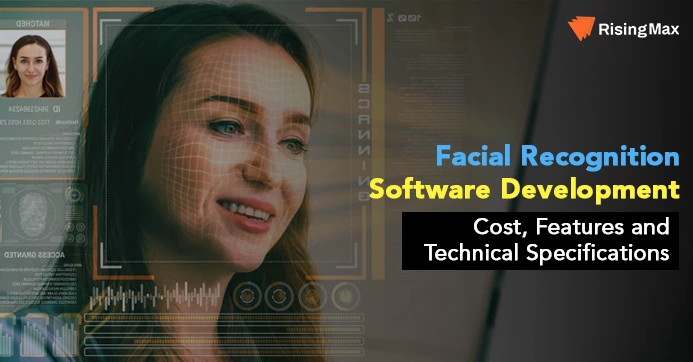Facial recognition technology has become a popular biometric authentication method for various applications in recent years. The software uses deep learning algorithms to analyze and compare patterns in facial features to identify individuals.
The facial recognition market is projected to reach USD 3.8 billion by 2025 at a CAGR of 17.2%. The increasing adoption of facial recognition technology by various industries, the defense sector, and government bodies worldwide makes it a lucrative business opportunity.

To ensure that your facial recognition security camera meets your specific needs, it is recommended to work with a development team that has experience in the field and can provide guidance on the most cost-effective solution. It is also important to consider the impact of privacy regulations and data protection measures, which can add additional costs to the development process.
It is essential to consider both before developing a sketch for the whole architecture. The facial recognition system performs greatly for the organization’s security, attendance maintenance, and in-house support. Software development companies are integrating new technologies such as AI, AR, VR & blockchain to make facial recognition software solutions future secure.
RisingMax has been serving the IT industry for 13+ years, delivering successful software solutions to clients globally. With a team of industry-expert developers, RisingMax has groundbreaking records of producing creative software with the latest technologies like artificial intelligence, machine learning, and Web3 development servicesWhat Is The Core Technology Behind Facial Recognition Software?
The core technology behind facial recognition software is computer vision and deep learning algorithms. The software uses a digital image of a person’s face as input and then processes the image to extract and analyze various features, such as the shape and size of the face, the distance between the eyes, and the position of the mouth and nose.
The software then compares these extracted features to a database of known faces to identify a match. The deep learning algorithms used in facial recognition software are trained on large datasets of labeled images to learn the patterns and relationships between different facial features. This allows the software to accurately recognize faces even under challenging conditions, such as poor lighting or variations in facial expression.
In addition to deep learning, other technologies such as 3D modeling, face detection, tracking, and biometric authentication may also be used in facial recognition software. These technologies work together to provide a robust and reliable facial recognition solution that can be used for a variety of applications, such as security, access control, and identity verification.
Align the current state of IT with your business strategy by hiring the most trustworthy Facial Recognition Development Company
Basic Features Of Our Facial Recognition Software
The basic feature of facial recognition software is to identify individuals based on their traits like unique identification and different identity. Basic facial recognition includes fingerprint verification, retina recognition, palm matching, voice and signature reading, and card verification. This generally includes characteristics that distinguish one identity from another.
Multi-Verification Methods
Our face recognition software supports fingerprint verification, eye recognition, hand geometry recognition, voice recognition, card recognition, and signature recognition.
Live Facial Recognition (LFR)
Live facial recognition is a face recognition tool that uses multiple camera feeds against the reserved list of identities in the database, which alerts when a matched face is detected.
Multiple Face Readability
When the number of employees in an organization increases, then multi-face readability can be used to help manage the details of each member. It can read up to 10,000 faces simultaneously, accomplished by a big-size LCD display.
Multiple Mode Of Facial Recognition
This feature entertains 3 different methods for facial verification. A verification process may be settled with face or card or face and card both. It improves security and doubles check, if necessary.
Remote Upgrade
Many small organizations and startups, later in the future, may need to upgrade their lively software. It can be upgraded remotely by integrating the system with our interface.
Cloud-DB Approach
Any existing system may discover an exceeding number of faces than the limit, which can easily be rectified by upgrading the limits to 20,000 faces or even more.
Advanced Features Of Our Facial Recognition Software
Although the functionality of the developed face recognition software differs from one another, there must be some specific features that each advanced software should carry:
Face Identification
Our software uses a face recognition device and searches for human faces. This is a challenging process in which precision should be met while ensuring face identification must be retrieved and validated from the database within the existing system. Our high-performance FRS software can identify and analyze the number of faces it has identified.
Face Recognition
The software will look for a face, and once the system has identified it, it will look into the database. Upon retrieval, the data table searches for the right match enrolled in the database. After confirmation, our software ensures to provide a high level of encryption, exploitation of the database, and privacy.
Embedded Facial Recognition
It gives a seamless experience with a secure and robust feature. A user doesn’t require any machine learning skills to use embedded facial recognition. This face recognition feature can perceive the face and facial attributes like glasses, masks, and locations. This feature enables the face recognition device to identify in multiple ways. It can be either by a picture, photo ID, or image stored in the cloud database.
Physical Attributes Recognition
It is the ultimate face identification tool that integrates easily into the software for better performance of businesses. It enables a special feature that detects face recognition by age, gender, and other attributes. It helps identify age detection, gender detection, and anti-spoof detection. It is capable of identifying diverse images of the human face as well.
Repository Database
It is an advanced feature that deals with the repository database of facial IDs. It stores the facial records and attributes in the existing database of the IT system. It captures the image and compares it to find an accurate match. The anti-spoofing uses “liveliness identification,” which performs the test with the help of a video camera. It can detect for up to 15 faces at the same time, which makes the IT system more efficient and time-saving.
Facial Recognition Use Cases Analysis
Artificial intelligence used in facial recognition empowers several benefits. It helps secure a working environment, fixes any sustainable changes, and improves user experiences. Let’s discuss a few used cases to understand it better.
Facial Recognition For Access Control
The access control authorizes access to a particular subject, restricts access to a specific location, or provides resources. It is a selective restriction to provide access to certain people for certain things.
An easy example would be access control in commercial and residential areas. The system will not entertain unknown identities and only allow those living or working in the areas. The system will put all the records in a database and not allow unauthorized access.
Access Control In The Airport System
For the aviation industry, boarding passengers is one of the travel bottlenecks, but many airport authorities have deployed facial recognition software in their systems. It provides self-service kiosks and allows them access to all the benefits they can entertain while ensuring that it wouldn’t hurt the application’s architecture.
Using this will facilitate the onboarding of passengers with the following:
- Attendance in flight
- Readability of the customer’s regular habit
- History of their boarding/arrival
- Prioritize the clients’ depending on the class
Planning to get high-end Facial Recognition software?
Get free consultation for facial recognition software development from a leading software development company.
Facial Recognition For Security And Surveillance
Surveillance systems are everywhere, and they are greatly enhancing safety and security. From security cameras to video surveillance, effective management will use digital identity to protect the system from unauthorized use.
Safeguarding Warehouses And Factories
Warehouses and factories carry very sensitive data and information. These are used to store manufacturing goods before the shipping process takes place. The goods undergo a complex and rigid process that must be ensured if proper facial recognition software is installed. The secured system will not entertain outsiders to entry in the firewall and only allows the workers and staff to access it after providing the credentials.
Facial Recognition For Time & Attendance
The traditional clock in and out the pattern for time and attendance requires physical identities like badges, personal information like employee Id, or digital verification like a biometric process. However, these processes could be more flexible and convenient, and there is a lot more risk attached. Employees may lose their badges, forget their ID, or have readability issues from biometrics checks.
Now, companies are introducing facial recognition systems that will improve face readability and put it on the top measure as digital identity verification. It consists of features like
- Contactless Support
- Enroll with the picture
- Supportive to all cameras
- Highly accurate
- Prevents hazardous situations
Facial Recognition For The Fintech Services
KYC has become a trending global practice for fintech solutions. With the help of KYC, financial institutions verify the identity and associated risk factors for business relationships. It helps validate the money laundry schemas where banks and financial institutions can easily verify the customers’ identity.
It also secures the system, restricts unauthorized access, and develops the system to be more efficient and robust. Facial recognition can transform the traditional KYC process into a digital revolution.
Example:
- To Open A Bank Account
- Request accepted to open a bank a/c.
- The authorized individual will take the picture, process it through eKYC, and scan it for Id proof.
- Using facial recognition software, biometrics verification will be processed.
- Bank will check and confirm the legal and financial stand of the client.
- The account is open, and the client has all access to the banking.
Facial Recognition For Hospitality
Face recognition can be used in the hospitality industry, like hotels and lodging. Hotels can use face recognition to discover who are premium clients and who are the VIPs. Upon arrival, the system alerts the responded individual to serve tailored assistance services per the client’s preferences. It can be anything like floor rooms, suits, or premium services they would indulge in before.
RisingMax has been serving the IT industry for over a decade, and It’s a popular name in the US for software development. You can shoot your queries, and we will answer you very soon. You are always welcome to enquire about your projects, and we will be more than happy to assist you.How Much Does Facial Recognition Software Cost?
Similar to any software development project, there’s no fixed cost associated with facial recognition software. Multiple cost-driving factors directly impact the facial recognition software cost making it difficult to share a fixed development cost. Let’s discuss these cost-driving factors in detail.
Major Facial Recognition System Cost Driving Factors Include The Following;
- Type of Facial Recognition Software
- Integrated Features
- Required Tech Stack
- Location of the Software Development Company
- Team Expertise
- Project Duration
- Add-on features.
Most custom facial recognition software development service providers and companies carefully evaluate these factors and share estimated project costs. Usually, the facial recognition system cost ranges between $40,000 to $50,000. However, the development cost might increase based on the above-mentioned factors. It is worth mentioning that team location plays a crucial role in the final project cost. For example, there is a difference in rates of software developers in Uruguay, Mexico, Poland and software developers in the US.
Want an exact facial recognition software development cost? Then, connect with our subject matter experts at RisingMax Inc. today. Our team, after carefully analyzing and evaluating your facial software needs to share a customized quote ASAP.
Facial Recognition Software Development Process We Follow
We at RisingMax Inc., follow an agile and well-documented development process that empowers us to reduce the facial recognition security system cost. Our facial recognition software development process starts with the following;
Requirements Gathering
During this stage, our experts connect with the client to understand the facial recognition software development vision and objective. Our experts gather information about the target audience, platform type, project scope, and integrated features.
Analysis and Validation
Our experts gather around to analyze the client’s project needs and conduct a market survey to validate the idea. Only after clearing this software development phase, we move towards the project planning and development phase.
Project Planning
During this stage, our software development experts create a project roadmap and transform the client’s vision into reality. We divide the project into smaller development milestones for effective project monitoring and timely project completion.
Design and Development
With a clear roadmap in mind, our experts start the facial recognition software development process. User-friendly interface and integration of key features are the main points of focus of our development experts.
Software Testing
Our QA team employs best-in-industry testing tools and methodologies to offer bug-free solutions to our clients. Any technical bug or optimization issue will be sent to the development team for rectification.
Maintenance and Support
We offer cost-effective maintenance and support services for timely updating software, optimizing the app, and resolving technical bugs with the application.
Trends To Shape Facial Recognition In 2023
The virtual identity is in charismatic flux because investors, giant IT industries, and the government sectors grapple with the transformation in real essence. It is to put over virtual identity as one of the major implementations in the IT sector. The trends that can emphasize the latest technology and are facing serious challenges will shape the virtual identity by 2023. Let’s have a quick look at these trends!
Artificial Intelligence Capabilities
Artificial intelligence and machine learning is the new trend set in the market. Google has already deployed AI and ML in its algorithm (Rankbrain) for search engine ranking position, how the bots would interact with landing pages, and implementation of the user auto-predictive results. Artificial intelligence sounds more actionable than how general software reacts. AI is no more a book concept but rather the reality on the ground, shaping today’s future with the utmost respect to keep advancing technology.
- Facial Recognition For The Safety Of Home: The safety of our home gives us more peace of mind. And artificial intelligence, from the entry doors to the protection of the full house and assets, strengthens the capability to safeguard the home. Facial recognition would enhance access to the full functionalities of artificial intelligence in real life. AI is developing more home-based applications, from front doors to remote residential access.
- Highly Intuitive Assistance: Scheduling things and being informed, like scheduling tasks, meetings, calendars, and playing music, are a few examples of high AI that will make things easy. Artificial intelligence has already shown its capabilities with Cortana, Alexa, and Siri applications that work on “voice over command.” applications based on these technologies will perform more personal assistance that serves more reality. This can be considered an alternate option to robotic iterations to do more as a reality.
- Use Of Face As One’s Identity: Facing recognition can facilitate payment methods, security concerns, and access to a particular platform. In a digital world, facial recognition is a crucial game-changer when your face becomes your real identity rather than your self-identity. We have seen how the passwords and other types of accessing credentials have failed to put the remark, and later it was misused purposely. Similarly, facial recognition is an intuitive way to generate your identity, and there is no way you are going to put yourself in any doubt at all.
- Cost Of Facial Recognition Software: The development cost of facial recognition software is based on the nature of the software and its services. The charges may vary depending on the invested technology, available features, the design of the software, and the functionalities it provides. However, some other factors arise from the developer’s end because a pool of involved developers can affect the pricing. Factors include software cost, resources, database usage, platform dependencies, software complexity, the development team’s experience, and working hours.
- Industry-Level Facial Recognitions Software Cost: The exact cost of facial recognition software can never be precise because some other factors are involved. But it is not as simple as that. The development team will go through all the phases of development and figure out the used technology, project requirements, business objectives, scope of work, and utilized resources.
Still, a fair sketch of the pricing may be estimated by the value provided below:
Other miscellaneous factors that may affect the pricing are the region, development company, and the IT systems it is going to integrate with.
| Company Size | Cost | Manpower |
|---|---|---|
| Small Size Company | $30,000 to $50,000 | 50-200 |
| Mid Size Company | $50,000 to $70,000 | 200-1000 |
| Large Size Company | $70,000 to $1,20,000 | 1000-10,000 |
Final Words
Facial recognition is diversifying the used cases of the platform to investigate and find robust solutions to adhere to the new age guidelines of virtual identity. Many IT professionals worldwide have claimed that biometrics identity and facial recognition will play a major role in digital identities for individuals. In 2017 when Apple Inc. launched the Face ID platform, it was not merely just a platform to use but also a “wow factor” in terms of security purposes.
Securing physical and online assets is now becoming more prominent than ever because, after the pandemic, the cases of escalation in cybersecurity have been a major concern for the World. The introduction of artificial intelligence and machine learning over the internet has brought facial recognition software and biometrics authentication to play an important role in the sentiment of the professional IT world.












